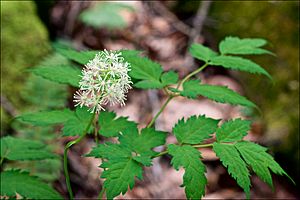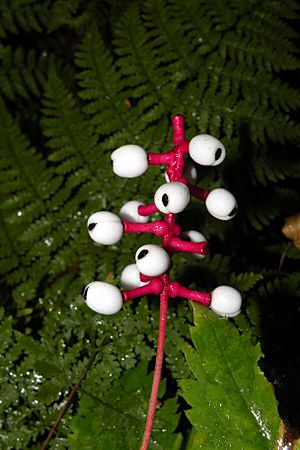White baneberry facts for kids
Quick facts for kids White baneberry |
|
|---|---|
 |
|
| flowers and leaves | |
| Conservation status | |
| Scientific classification | |
| Genus: |
Actaea (plant)
|
| Species: |
pachypoda
|
Actaea pachypoda, the white baneberry or doll's-eyes, is a species of flowering plant in the genus Actaea, of the family Ranunculaceae.
The plant is native to eastern North America, in eastern Canada, and the Midwestern and Eastern United States. It prefers clay to coarse loamy upland soils, and is found in hardwood and mixed forest stands.
Contents
Description
This herbaceous perennial plant grows to 46–76 cm (18–30 in) or more tall. It has toothed, bipinnate compound leaves up to 40 cm (16 in) long and 30 cm (12 in) broad.

The white flowers are produced in spring in a dense raceme about 10 cm (3.9 in) long. The plant's most striking feature is its fruit, a 1 cm (1⁄2 in) diameter white berry, whose size, shape, and black stigma scar give the species its other common name, "doll's eyes". The pedicels thicken and become bright red as the berries develop.
The berries ripen over the summer, turning into fruits that persists on the plant until frost.
There are pink- and red-berried plants that have been called A. pachypoda forma rubrocarpa, but some of them produce infertile seed, and may actually be hybrids with Actaea rubra.
The specific name pachypoda means "thick foot", from Ancient Greek παχύς pakhús "thick" and πούς poús "foot", which could refer to the large rhizome of the plant or to the stalks supporting the berries, which are thicker than the closely related Actaea rubra.
Toxins
Both the berries and the entire plant are considered poisonous to humans. The berries contain cardiogenic toxins which can have an immediate sedative effect on human cardiac muscle tissue, and are the most poisonous part of the plant. Ingestion of the berries can lead to cardiac arrest and death.
Ecology
A variety of birds, which are not affected by the toxins, eat the berries and help disperse the seeds. Long-tongued bees collect pollen from the flowers.
Cultivation
Actaea pachypoda is cultivated as an ornamental plant, in traditional and wildlife gardens.
It requires part or full shade, rich loamy soil, and regular water with good drainage to reproduce its native habitat.
See also
 In Spanish: Actaea pachypoda para niños
In Spanish: Actaea pachypoda para niños
- List of poisonous plants


